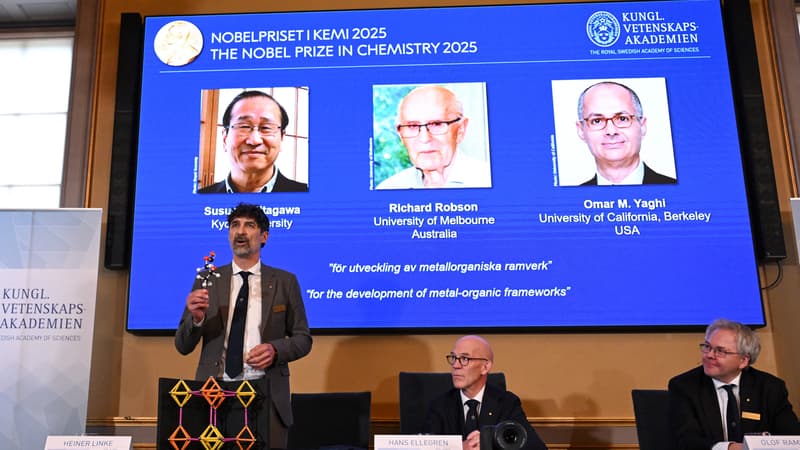The Nobel Prize in Chemistry 2025 received this trio of chemicals this Wednesday, October 8, which developed new molecular structures capable of imprisoning gases.
The trio composed of the Japanese Susumu Kitagawa, Richard Robson, born in the United Kingdom, and the Omar M. Yaghi American-Jordano was rewarded by “the development of metallo-organic structures” (MOF), according to the jury.
“These constructions, metal-organic structures, can be used to recover the water from the desert air, capture carbon dioxide, store toxic gases or catalyze chemical reactions,” the committee said in a press release. The names of Yaghi and Kitagawa have returned for several years in expert forecasts for Nobel Chemistry.
“A great potential”
These structures “have enormous potential, because they offer previously unsuspected possibilities of creating custom materials with new functions,” said Heiner Linke, president of the Nobel Chemistry Committee, in a press release.
When the constituent elements used in MOFS vary, “chemicals can design them to capture and store specific substances. MOF can also trigger chemical reactions or boost electricity,” says the Nobel Committee.
When exploiting these discoveries, “one could imagine creating materials capable of separating carbon dioxide from air or industrial exhaust pipes, or that could be used to separate the molecules of toxic wastewater,” said Hans Ellegren, general secretary of the Academy of Sciences that the Nobel grants.
The first advance dates back to 1989
Yaghi, 60, works in Berkeley in California, and Kitagawa, 74, is a professor at the University of Kyoto. Robson, 88, is a professor at the University of Melbourne, Australia. The first advance dates back to 1989 when Richard Robson proves a new way to use the properties of atoms using copper ions.
“When they combined, they linked to form a spacious and well -tidy crystal. It was like a diamond full of innumerable caries,” the committee said.
However, this construction was unstable. Omar M. Yaghi and Susumu Kitagawa then developed a “solid base” for the method of building these structures, each making “revolutionary discoveries.”
Susumu Kitagawa “has shown that gases could enter and leave the constructions and predicted that MOFS could be flexible,” said the committee.
Meanwhile, Omar Yaghi has created “a very stable MOF and has shown that he could be changed from” confer “new attractive properties,” according to the presentation.
“Science is the greatest force in the world to put equality”
When the price announces, Omar, Mr. Yaghi, said he was “amazed, enchanted, annoying.” The winner, born in a family of refugees in Jordan, recalled his very humble origin.
“I grew up in a very modest house. We were a dozen in a small room, which we shared with the cattle we grew,” he reminds of the Nobel Foundation.
His parents sent him to study at the age of 15 in the United States. “It’s a great course,” he added. “Science is the greatest strength in the world to put equality,” among people, said Omar, Mr. Yaghi.
For his part, Susumu Kitagawa said he was “very honest and delighted that my long -standing investigation has distinguished himself”, during a telephone interview shortly after the prize was announced.
“I am not very good with myself. I just start in everything that seems really interesting, so things are not always fluid,” he said during a press point in Japan.
Separate the pfa from the water?
The Nobel Committee has given examples of specific applications obtained from this investigation. “Yaghi’s research group has extracted Arizona’s desert water. During the night, its MOF material captured air water vapor. When the sunrise arrived and the sun warmed the material, they were able to collect water,” he exemplified.
The work of these chemicals has given birth to tens of thousands of new molecular networks different from other scientists. These networks could make it possible to separate eternal water pollutants, according to OLOF Ramström, professor of organic chemistry and member of the Royal Academy of Sciences.
For the winners of the 2025 harvest, the check that accompanies the price is 11 million crowns (920,000 euros), which will be shared between them.
Source: BFM TV


